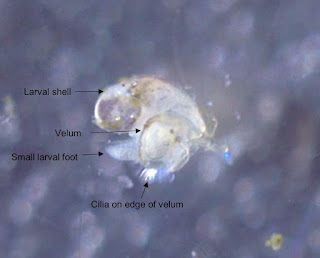The metamorphosis
"Als Gregor Samsa eines Morgens aus unruhigen Träumen erwachte, fand er sich in seinem Bett zu einem ungeheueren Ungeziefer verwandelt"
"As Gregor Samsa awoke one morning from anxious dreams, he found himself metamorphosed in his bed into a monstrous insect."
- Franz Kafka in The Metamorphosis, translation mine
Friends, I am back in Woods Hole and once again working on my experiment with Crepidula fornicata. I collected mothers from the field and kept them in different temperature and feeding conditions while they were brooding their larvae. Now that the larvae have hatched, I'm collecting data to see if there are any carryover effects. As I've already mentioned, I'm measuring the sizes of the larvae as they grow. I am also seeing how long it takes the larvae to develop to metamorphosis.
Everyone is familiar with at least one example of metamorphosis, which is a caterpillar becoming a butterfly (or a human becoming an insect, if you're into early 20th century Existentialist literature). You may or may not be aware that marine larvae do the same thing. In most cases, the larva looks nothing like the adult form, so larvae go through a transformation when they settle. Their tissues are rearranged; some structures are re-absorbed; others are constructed for the first time; and the animal looks totally different when it's done. In one extreme case called "catastrophic metamorphosis," ribbon worm juveniles develop inside the larval body and then eat their way out of the larval body when it's time for metamorphosis. (I'm not kidding; watch a video of the process here.)
For Crepidula, metamorphosis isn't too extreme. The larval swimming organ, the velum, disappears, and the muscular foot grows larger. The cilia that once kept the larva suspended in the water column are shed. The spiral-shaped larval shell grows a new brim so the juvenile can sit flat on a surface. That's it. What's really nice, though, is that metamorphosis can be reliably triggered by exposure to potassium chloride. Stick a Crepidula larva in 20 mM KCl, and if it is ready to metamorphose, it will. This means KCl exposure can be used to assess whether a larva is competent (ready to metamorphose) or not.
So every few days, I'm taking a sub-sample of larvae and exposing them to KCl. I leave them overnight, and then I come back and count how many have metamorphosed. So far, it looks like there might be some differences between larvae from different mothers. I'm excited to have data!
"As Gregor Samsa awoke one morning from anxious dreams, he found himself metamorphosed in his bed into a monstrous insect."
- Franz Kafka in The Metamorphosis, translation mine
 |
| A Crepidula fornicata larva before metamorphosis |
Friends, I am back in Woods Hole and once again working on my experiment with Crepidula fornicata. I collected mothers from the field and kept them in different temperature and feeding conditions while they were brooding their larvae. Now that the larvae have hatched, I'm collecting data to see if there are any carryover effects. As I've already mentioned, I'm measuring the sizes of the larvae as they grow. I am also seeing how long it takes the larvae to develop to metamorphosis.
 |
| A Crepidula juvenile after metamorphosis, laying on its back so the foot is exposed |
Everyone is familiar with at least one example of metamorphosis, which is a caterpillar becoming a butterfly (or a human becoming an insect, if you're into early 20th century Existentialist literature). You may or may not be aware that marine larvae do the same thing. In most cases, the larva looks nothing like the adult form, so larvae go through a transformation when they settle. Their tissues are rearranged; some structures are re-absorbed; others are constructed for the first time; and the animal looks totally different when it's done. In one extreme case called "catastrophic metamorphosis," ribbon worm juveniles develop inside the larval body and then eat their way out of the larval body when it's time for metamorphosis. (I'm not kidding; watch a video of the process here.)
 |
| A juvenile Crepidula crawling in a petri dish. (If you can't tell, I got a new microscope with a built-in camera!) |
For Crepidula, metamorphosis isn't too extreme. The larval swimming organ, the velum, disappears, and the muscular foot grows larger. The cilia that once kept the larva suspended in the water column are shed. The spiral-shaped larval shell grows a new brim so the juvenile can sit flat on a surface. That's it. What's really nice, though, is that metamorphosis can be reliably triggered by exposure to potassium chloride. Stick a Crepidula larva in 20 mM KCl, and if it is ready to metamorphose, it will. This means KCl exposure can be used to assess whether a larva is competent (ready to metamorphose) or not.
So every few days, I'm taking a sub-sample of larvae and exposing them to KCl. I leave them overnight, and then I come back and count how many have metamorphosed. So far, it looks like there might be some differences between larvae from different mothers. I'm excited to have data!
Comments
Post a Comment